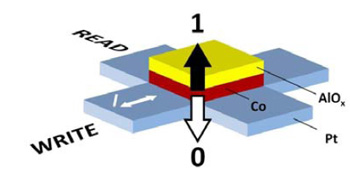Aug 2 2011
Computer files that allow us to watch videos, store pictures, and edit all kinds of media formats are nothing else but streams of "0" and "1" digital data, that is, bits and bytes. Modern computing technology is based on our ability to write, store, and retrieve digital information as efficiently as possible. In a computer hard disk, this is achieved in practice by writing information on a thin magnetic layer, where magnetic domains pointing "up" represent a "1" and magnetic domains pointing down represent a "0".
The size of these magnetic domains has now reached a few tens of nanometers, allowing us to store a Terabyte of data in the space of just about 4 square centimeters. Miniaturization, however, has created numerous problems that physicists and engineers worldwide struggle to solve at the pace demanded by an ever-growing information technology industry. The process of writing information on tiny magnetic bits one by one, as fast as possible, and with little energy consumption, represents one of the biggest hurdles in this field.
As reported this week in Nature, a team of scientists from the Catalan Institute of Nanotechnology, ICREA, and Universitat Autonoma de Barcelona, Mihai Miron, Kevin Garello, and Pietro Gambardella, in collaboration with Gilles Gaudin and colleagues working at SPINTEC in Grenoble, France, have discovered a new method to write magnetic data that fulfils all of these requirements.
 Schematic of a magnetic bit fabricated by
sandwiching a thin ferromagnetic Co film between Pt and
AlOx layers. Current pulses injected through one of the Pt
strips switch the magnetization from up to dowand
viceversa depending on the sign of the current.
Schematic of a magnetic bit fabricated by
sandwiching a thin ferromagnetic Co film between Pt and
AlOx layers. Current pulses injected through one of the Pt
strips switch the magnetization from up to dowand
viceversa depending on the sign of the current.
Magnetic writing is currently performed using magnetic fields produced by wires and coils, a methodology suffering severe limitations in scalability and energy efficiency. The new technique eliminates the need for cumbersome magnetic fields and provides extremely simple and reversible writing of memory elements by injecting an electric current parallel to the plane of a magnetic bit. The key to this effect lies in engineering asymmetric interfaces at the top and bottom of the magnetic layer, which induces an electric field across the material, in this case a cobalt film less than one nanometer thick sandwiched between platinum and aluminum oxide.
Due to subtle relativistic effects, electrons traversing the Co layer effectively see the material's electric field as a magnetic field, which in turn twists their magnetization. Depending on the intensity of the current and the direction of the magnetization, one can induce an effective magnetic field, intrinsic to the material that is strong enough to reverse the magnetization. The research team showed that this method works reliably at room temperature using current pulses that last less than 10 ns in magnetic bits as small as 200 x 200 square nanometers, while further miniaturization and faster switching appear easily within reach. Although there is currently no theory describing this effect, this work has many interesting applications for the magnetic recording industry, and in particular for the realization of magnetic random access memories, so-called MRAMs. By replacing standard RAMs, which need to be refreshed every few milliseconds, non-volatile MRAMs would allow instant power up of a computer and also save a substantial amount of energy.
An additional advantage of the discovery reported here is that current-induced magnetic writing is more efficient in "hard" magnetic layers than in "soft" ones. This is somehow counterintuitive, as soft magnetic materials are by definition the easier to switch using external magnetic fields, but very practical since hard magnets can be miniaturized to nanometer dimensions without losing their magnetic properties. This would allow the information storage density to be increased without compromising the ability to write it. The results of this work have also led to three patent applications dealing with the fabrication of magnetic storage and logic devices.